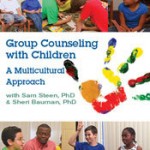 In these videos, Sam Steen, Ph.D., and Sheri Bauman, Ph.D., utilizes therapeutic interventions in their group counseling collaboration to create effective ways of educating children about diversity. Steen and Bauman introduce the video by sharing the necessary steps in group formulation and preparation: planning, screening, modeling, self-disclosure (not too personal), processing (reflect, think and ponder) and evaluating (age appropriate and specific to the group). Throughout these videos, counselors are instructed in how to replicate groups.
In these videos, Sam Steen, Ph.D., and Sheri Bauman, Ph.D., utilizes therapeutic interventions in their group counseling collaboration to create effective ways of educating children about diversity. Steen and Bauman introduce the video by sharing the necessary steps in group formulation and preparation: planning, screening, modeling, self-disclosure (not too personal), processing (reflect, think and ponder) and evaluating (age appropriate and specific to the group). Throughout these videos, counselors are instructed in how to replicate groups.
Steen and Bauman co-facilitate this group to help these children understand cultural diversity, or multiculturalism. They create a safe environment in which children can interact, and they teach diversity using fun educational tools such as ice cream and songs. Therefore, demonstrating diversity is constantly prevalent in our surroundings.
A unique perspective on the demonstration of activities is displayed in this video, which also illustrates how a therapeutic bond is formed. This positive bond between youth and counselor can be based on relational features, such as the degree to which the therapist is being stimulating, humorous or rewarding, especially with young children. The video is exceptional in how the children are addressed and encouraged to engage.
The lack of cognitive development can limit a younger client’s ability to evaluate connections between therapy tasks and goals, and the involvement of parents and other caregivers in youth therapy can complicate the issue of goal consensus. Steen and Bauman effectively illustrate how to go beyond such roadblocks to create a therapeutic alliance and establish treatment outcomes for these multicultural issues.
Throughout the video, Steen and Bauman illustrate both humorous and serious themes that can be addressed in diversity. There are a total of six (6) sessions, all of which contain information that a therapist can take away and utilize when leading groups, or even with younger individual clients. Different activities are carried out throughout the sessions, such as “diversity beans,” “name color,” “comfort zones,” and “about your culture,” to name a few. Some of these can be used in the classroom to make children more aware of diversity, whether it will be processed further than the surface level observations or not. Although every activity has an element of fun, each activity is effective and always follows through with purpose and reflections. Despite the fact that counselors and clients were videotaped, they were able to give an accurate depiction of group dynamics and cohesion, as well as therapeutic practices and outcomes.
While therapeutic styles are personal and are as important as techniques and theories, counselors can utilize these techniques to blend with their own styles and the needs of their clients to produce valuable outcomes. This video shows that Steen and Bauman are successful in demonstrating a practical and technical approach using innovative techniques and activities.
I would highly recommend this video to anyone who works with younger clients even if it is only to add techniques to your battery of information to help these young people view the world in a new way by appreciating differences.
Psychotherapy.net (Producer), & Gallego, T. (Director). (2011). Group counseling with children: A multicultural approach [DVD]. Available in DVD and video streaming from http://www.psychotherapy.net/video/diversity-group-children
Reviewed by: Josephine L. Rodriguez, NCC, doctoral counseling student, Barry University, Miami Shores, Florida.
The Professional Counselor Journal
